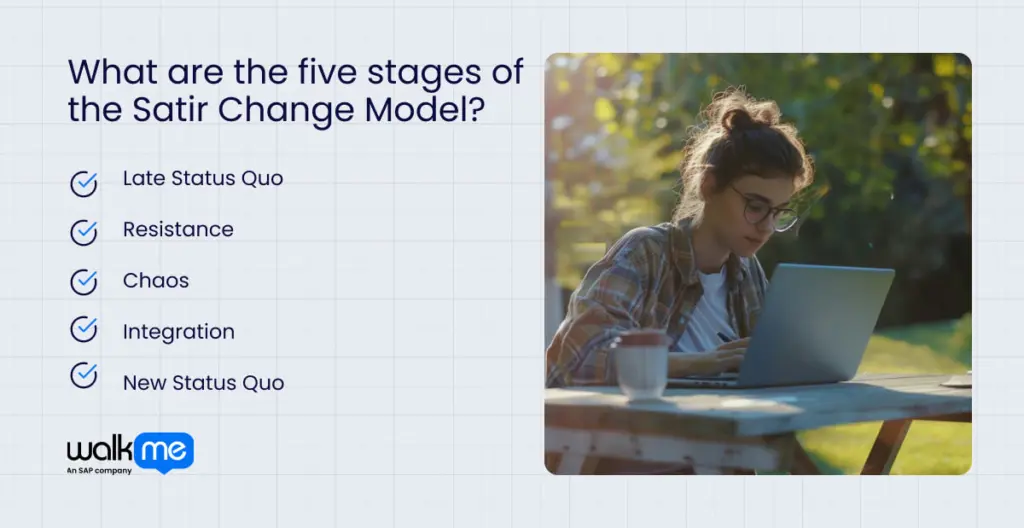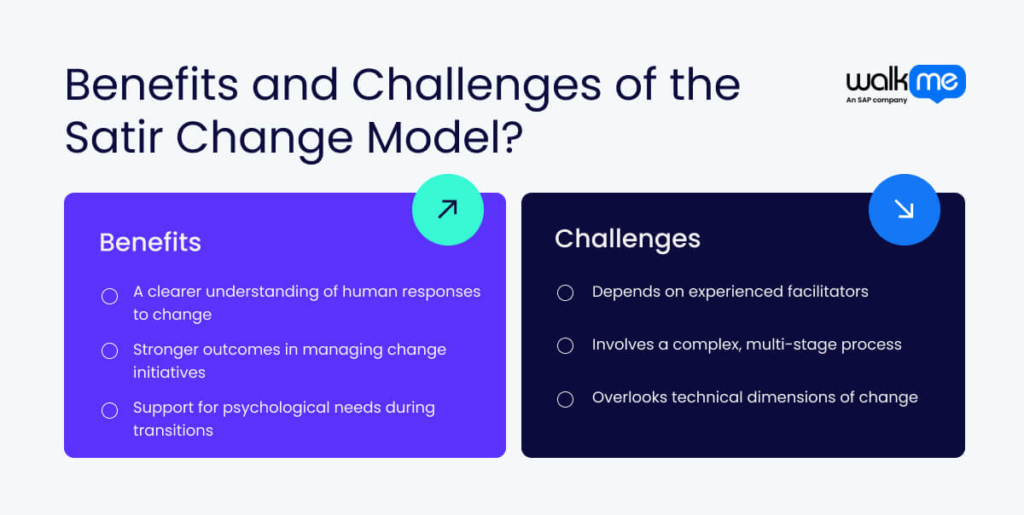The Satir Change Model is a psychological framework for change management developed by Virginia Satir. It illustrates the emotional journey individuals undergo during the change process.
Recognizing that transformation is often met with resistance, Satir’s model emphasizes the human aspect of change, highlighting the emotional turbulence and eventual integration that individuals usually experience.
Research from the Journal of Organizational Behavior indicates that addressing these mechanisms can enhance the adoption and long-term success of organizational transformation.
With that in mind, this article explores how the Satir Change Model works, why it matters on the enterprise level, and how it can be applied to guide teams through real-world change.
What is the Satir Change Model?
The Satir Change Model is a change management framework that maps the emotional and psychological journey individuals and organizations experience during change.
It identifies the following five stages:
- Late Status Quo
- Resistance
- Chaos
- Integration
- New Status Quo
The model stresses that change impacts feelings as much as processes, drawing attention to fear, uncertainty, and resistance.
Recognizing these emotional responses gives change leaders a practical advantage. Instead of treating change as a series of tasks, they can anticipate fear, confusion, and resistance, guiding teams with heightened empathy.
Why is the Satir Change Model important?
Satir’s Change Model is important because it humanizes organizational transformation, focusing on people’s emotional journey and not just processes.
The best way to gauge the importance of this model is to visualize a hypothetical technology company rolling out a new AI platform. Consider C-Suite executives who face resistance due to employees’ frustration with the disruptions to their workflows.
Applying Satir’s model in this instance lets leaders openly acknowledge anxiety, facilitate open dialogue, and provide support. It’s a great way to soften resistance and ensure employees feel heard and valued.
What are the five stages of the Satir Change Model?

Understanding the five stages of the Satir Change Model is more nuanced than memorizing labels. It requires seeing how each stage reflects human reactions to change and influences organizational outcomes.
Let’s take a closer look at the five stages of the Satir Change Model:
Late status quo
The late status quo is often the calm before the storm. Organizations run on routines people are familiar with, even if they are inefficient. At this stage, staff have adapted, developing workarounds and habits that make the system “good enough.”
Understanding this stage involves recognizing where people feel secure and allowing leadership to introduce change without triggering unnecessary anxiety. Think of the late status quo as the starting point for transformation, where insight should guide future moves.
Resistance
When employees push back, they’re highlighting gaps between leadership intentions and daily realities. In practice, this is where experience matters most. Seasoned executives listen, ask clarifying questions, and turn objections into opportunities.
The resistance stage exposes hidden dependencies, overlooked risks, and latent frustrations. Handling it poorly can cause disengagement, but when approached thoughtfully, it can build credibility.
Chaos
Chaos is uncomfortable, unavoidable, and should be relatively enlightening. It’s the point when old routines crumble, and nothing feels predictable. Leaders should recognize that this stage is temporary yet vital and communicate to clarify responsibilities and encourage iterative problem-solving.
Because process fragility is exposed in this stage, it opens space for innovation. While teams may feel disoriented, it’s all fertile ground for learning. Those who guide staff through chaos usually turn anxiety into something useful.
Integration
Integration is where change begins to stick and new habits are formed. Employees stop following instructions and adapt to the new ways on their own. This is reinforced through coaching, feedback, and acknowledging progress.
Try not to force compliance in this stage, and instead align human behavior with business goals while retaining autonomy. This will help determine whether the transformation lasts. Enterprises that master integration see improved workflows, fewer errors, and stronger team cohesion.
New status quo
The new status quo represents stability earned through adaptation. Given time, teams operate efficiently, leadership measures results, and the organization functions with heightened confidence. Employees have internalized new ways of working and now trust the systems in place.
Seasoned leaders recognize this as a full-circle moment or a starting point, rather than an ending point. This stage reflects the deliberate effort, learning from resistance, and resilience built during chaos.
How to apply the Satir Model for change management
Now that you’re familiar with the five stages of the Satir Model for change management, it’s time to learn how to apply it in the real world. Understanding these stages helps businesses streamline implementation, allowing them to read the emotional climate of their teams.
Let’s take a closer look at how to apply the Satir Model for change management:
Learn the model and its stages
Understanding the Satir model involves recognizing how people feel and respond during times of change. Teams don’t resist change itself; they usually resist uncertainty and lack of clarity. Watching how people communicate and interact helps leaders anticipate problems before they happen.
Companies that pick up on these signals can guide change more smoothly. This stage shows the Satir model’s central idea that change is human first, and reading emotions at the start sets the foundation for everything that follows.
Evaluate the current state (Late Status Quo)
Before making changes, it’s important to see how employees tackle work challenges. Processes may look fine on paper, but employees often have informal ways to keep things moving.
This reflects the Satir Model principle of starting from reality and knowing where people are before asking them to move. Understanding these routines helps leaders determine what to keep and what to adjust. Businesses that study real-world workflows can introduce improvements that are a natural fit.
Prepare for resistance and disruption
Pushback is normal and often shows people care about the outcome. It can appear as uncertainty, worry about new tasks, or confusion over roles. Preparing for it with clear communication and support keeps teams from getting stuck or frustrated.
At this stage, the Satir model views resistance as a signal to guide leaders on where attention is needed. Disruption is reframed as a diagnostic tool, revealing overlooked dependencies and inefficiencies.
Support integration and experimentation
Integration works best when employees are encouraged to adapt new methods while retaining agency. Trying out new tools, processes, and ways of working reveals solutions that fit how the organization operates.
Enterprises that create a culture of controlled experimentation tend to accelerate adoption and sustain productivity during transitions. The emphasis is on embedding change into routine work without stifling ambition and striking a balance between control and employee-driven refinement.
Create the new status quo
Change takes hold when employees can try new ways of working and see what sticks. Testing tools, processes, or methods of communication reveals what works and what needs adjustment. Celebrating small wins and learning from mistakes builds confidence and speeds adoption, a key part of the Satir model.
Companies that allow controlled experimentation help employees make the change themselves. New practices require reinforcement and visible validation. Clarifying procedures and responsibilities, and highlighting early successes, also ensures that behaviors are internalized.

What are the benefits of the Satir Change Model?
Understanding the benefits of the Satir Change Model means seeing change as a human process. It shows how emotions shape outcomes and helps leaders navigate transitions with confidence.
Let’s take a closer look at the benefits of the Satir Change Model:
A clearer understanding of human responses to change
People rarely resist change itself. Instead, they usually resist feeling unsure, overlooked, or unprepared. The Satir Model enables leaders to read these emotions in near real-time. Understanding how teams react allows managers to adjust approaches before frustration grows. This awareness turns abstract plans into actions that employees can follow and trust.
Stronger outcomes in managing change initiatives
Projects often fail because leaders underestimate how people experience change. When models like Satir’s are applied, they ensure that strategies take into account human behavior. When employees feel guided and supported, adoption happens faster and results last longer. Teams work confidently because the approach respects how people respond, rather than just what a plan dictates should happen.
Support for psychological needs during transitions
Transitions can feel threatening even when they are necessary. The Satir Model emphasizes providing reassurance and clarity throughout the process. Employees who feel safe and understood are more engaged and focused. Supporting psychological needs keeps teams motivated and helps people embrace new ways of working without resisting.
What are the challenges of the Satir Change Model?
The Satir Model can be difficult to apply because people’s emotions are unpredictable and change rarely follows a straight path. Recognizing these challenges helps leaders guide transitions with insight and patience.
Let’s take a closer look at the challenges of the Satir Change Model:
Depends on experienced facilitators
The Satir Model only works when leaders understand human behavior. Inexperienced facilitators can misread hesitation or frustration, applying solutions that backfire. Teams may feel misunderstood or unsupported, which can slow down adoption. Skilled guidance is essential because the model relies on interpreting subtle emotional cues and responding in ways that earn trust and engagement.
Involves a complex, multi-stage process
Applying the Satir Model requires navigating several interwoven steps that unfold over time. Leaders must pay attention to emotions, behaviors, and reactions at each point. Rushing or skipping phases risks creating confusion and resistance. Success comes from pacing the process carefully, giving people space to adjust while keeping the organization moving toward its goals.
Overlooks technical dimensions of change
People, not systems and tools, are the focus of the Satir Model. Technical hurdles, such as system integration or digital workflow redesign, can be underestimated, creating gaps between human readiness and operational capability. Leaders must pair emotional insight with practical problem-solving to ensure that both employees and processes align, or the transformation risks stalling despite strong engagement.
How the Satir Change Model helps organizations succeed
This article has provided an overview of the Satir Change Model and should help you apply it during times of enterprise change.
The most important takeaway here is that the Satir Change Model is a lens for seeing how people experience change, allowing organizations to guide transitions with insight and maintain momentum through uncertainty.
It’s worth noting that even with the best change management tools in your arsenal, success depends on understanding the human side of transformation and responding thoughtfully to the emotions and behaviors that drive outcomes.
Incorporate elements of the model that work for your business into your organizational training plan and continue refining until you create a cultural transformation that every member of your team embraces.
FAQs
Most frameworks focus on tasks and milestones. The Satir Model focuses on people and their fears, habits, and reactions. It shows leaders what’s really happening beneath the surface, so interventions feel intuitive rather than forced. Understanding emotions allows change to stick because you’re guiding both hearts and processes.
Digital transformation projects disrupt routines and comfort zones. The Satir Model helps leaders highlight anxiety, hesitation, and hidden blockers as teams adjust. It provides a human compass, so technology adoption isn’t just implemented but actually embraced and integrated into day-to-day work.
During chaos, teams feel unsteady and unsure. Leaders must read the room, calm nerves, and show what success can look like. They create room for experimentation, address frustration early, and model flexibility. Their presence turns uncertainty into learning, keeping the organization moving without losing trust or momentum.

